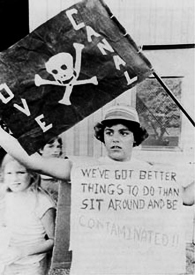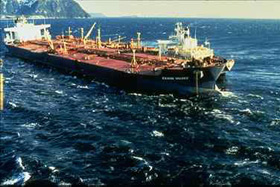Forty years after the first Earth Day, it’s easy to forget how far the U.S. has come in protecting the environment. Many of the biggest problems of the past are close to being solved—though others remain stubbornly resistant to repair. Here, then, are just some of the US’s most important environmental laws, crises and trends of the past four decades.
What’s on your list? What would you add? What do you think are the biggest victories, the most important trends, the lost opportunities and future problems facing the environment? Share your thoughts in our comment section at the bottom of the page.
Burning river symbolizes pre-Earth Day environmental calamities
In 1969, the Cuyahoga River in Ohio literally caught fire. A virtual sewer for oil and industrial chemicals, the Cuyahoga became a symbol of the ecological cost of unchecked pollution, and a rallying point for those who wanted to stop it.
Landmark environmental laws pass with massive bipartisan support
Today, when environmental issues are the stuff of partisan warfare, it’s hard to remember that ecologically-friendly laws were once acclaimed by most of the political spectrum. The National Environmental Policy Act (NEPA), which established the first federal environmental agency and required environmental impact studies for all major federal projects, passed the Senate unanimously. Richard Nixon’s first official act of the 1970s was to sign that bill into law. Nixon, in fact, signed virtually all of the most important environmental laws of that decade:
- The clean air act, 1970
- The clean water act, 1972
- The endangered species act, 1973
Together, those four laws (including NEPA) form the backbone of American environmental protection. Indeed, it’s impossible to imagine what the American ecosystem would look like without these laws. Unfortunately, though they’ve been renewed by subsequent Congresses and Presidents, portions of each are being gutted by court decisions and lack of enforcement resources.
Love Canal inspires a grassroots movement

A demonstrator at Love Canal, where town-wide contamination sparked local, then national, anti-toxics protests. (image: Environmental Protection Agency.)
Getting the lead out
 Though lead has been recognized as a poison for thousands of years, and no less a personage than Benjamin Franklin decried its “mischievous Effect,” the metal was ubiquitous in paint and gasoline, exposing children to neurological and organ damage. Finally, in 1975, with the mandated use of catalytic converters in cars, unleaded gas began to replace leaded. Lead-based paint was banned in ’78, and in 1986 the Safe Drinking Water Act limited lead in municipal water systems.
Though lead has been recognized as a poison for thousands of years, and no less a personage than Benjamin Franklin decried its “mischievous Effect,” the metal was ubiquitous in paint and gasoline, exposing children to neurological and organ damage. Finally, in 1975, with the mandated use of catalytic converters in cars, unleaded gas began to replace leaded. Lead-based paint was banned in ’78, and in 1986 the Safe Drinking Water Act limited lead in municipal water systems.
Accidents nearly kill the nuclear industry; climate change resurrects it

The Three Mile Island nuclear accident helped lead to a near-complete shut down of construction of new plants. (image: Dept of Energy.)
Oil spills generate public outrage

The Exxon Valdez founders where it crashed in Alaska’s Prince William Sound, where it spilled nearly 11 million gallons of oil.
Environmental justice vs. environmental racism
In the 1980s and ’90s, government agencies from the General Accounting Office to the EPA confirmed what non-profits and community activists had been saying for years: that race has been the most important factor in the siting of hazardous waste facilities—trumping even poverty. The civil rights and environmental movements converged in a national effort to rectify that trend with calls for “environmental justice.” Their efforts resulted in federal policies that are supposed to ensure that local communities have a chance to fight polluting facilities in their midst. It was a big victory—but the fight continues to make it a victory in practice as well as on paper.
The ozone hole inspires international treaties

Depiction of the hole in the ozone layer in 1999. (image: NASA.)
A market solution to acid rain

Acid rain killed trees and poisoned lakes, but a cap-and-trade program that employs market forces has significantly reduced the levels of acid rain in the US and Europe, and once-sick landscapes have begun to recover.
Is it getting hot in here?

The political debate over climate change will be the most interesting and consequential environmental issue of the next several years.
Environmentalism goes mainstream
Though environmentalists are caricatured as Birkenstock-wearing, granola-eating tree-huggers, being “green” has become a basic cultural stance. Environmental education appears in the earliest grades at school; recycling is mandated in thousands of communities; and corporations strive to be—or at least to seem—earth-friendly. As U-M professor Rachel Kaplan, an expert on environmental psychology points out, “environmental issues have become much more central in many aspects of American culture” than they were 40 years ago.



Rob Evans - 1969, SNR, B.Sc.
Over the forty years the “big busness/make money at all costs” attitude was very slow to change. In 1969 we collected a huge amount of soda cans and dumped them at a soda plant with signs demanding they recycle. I remember one project where my EA recommended that the engineering project not go ahead. My boss “an P.Eng.” received a letter from the head of Planning Dept.stating I that I change my conclusion or be fired. I said what would John Muir do and said NO. My boss called several Regulatory Agencies and they said I had a good reputation and he did not fire me. At another company they killed Lake Sturgeon by the thousands over 35 years. Once again M. of Nat. Res. called and I answered the phone this time and rather then go to my boss “a P.Eng” I told MNR that OH would go ahead with the rescue. Again I asked what would John Muir do and I acted to do the “right thing”. Ten years later the rescue was still going on and I saved thousands of Lake Sturgeon. The CEO of OH even gave me a big Sustainability Award. By the way I was critized by the engineers but they started to include the environment in their cost/benefit analysis calculations. I am retired now but I know I have done the right thing and changed the system that did not care about the Environment. Remember you will be tested and please do not be an “Environmental Prostitute”. Rob Evans, Toronto, Canada.-GO BLUE
Reply
Larry E. Fink - 1973
1969: Extensive oil spill from blow-out of off-shore drilling rig in Santa Barbra harbor provides impetus for Earth Day 1970 and subsequent ban on off-shore oil drilling.
1970: National Environmental Policy Act (NEPA)
1970: Nixon creates U.S. Environmental Protection Agency by Executive Order to implement NEPA and other environmental statutes
1970: Federal Clean Air Act Amendments
1970: Michigan DNR confirms high levels of mercury pollution of Lake St. Clair and Detroit River fish and birds caused by Michigan and Ontario chlor-alkali manufacturing plants
1970: Effects of 2,4,5-T on Man and the Environment. Hearings before the Subcommittee on Energy, Natural Resources, and the Environment, Senate Commerce Committee, April 7, 15, 1970.
1970-71: In response to mercury surprise, Michigan passes ground-breaking Truth in Pollution law requiring reporting of discharge of Critical Materials to the state’s waters. New Jersey’s later version, which borrows extensively from Michigan’s, becomes basis for Federal toxic substances release inventory (TRI).
1971: U.S. Supreme Court refuses to hear case of Ohio v. Wyandotte Chemical Co. over Lake Erie mercury pollution from chlor-alkali manufacture in Michigan.
1972: DDT is first polychlorinated pesticide to be banned by U.S. EPA.
1972: Congress passes Federal Water Pollution Control Act Amendments over Nixon’s veto with goal of zero discharge of toxic substances by July 1983.
1973: Federal Endangered Species Act
1973: Judge Miles Lord of Federal District Court of the District of Minnesota bans Reserve Mining Company discharge of asbestos-contaminated taconite mine tailings into Lake Superior (“The court cannot honor profit over human life.â€)
1973: Mix-up of Michigan Chemical Company’s Nutrimaster feed additive with Firemaster fire retardant at feed formulation station contaminates Michigan’s agricultural then human food supplies with polybrominated biphenyls (PBBs). This event becomes impetus for passage of Federal Toxic Substances Control Act (TSCA) of 1976.
1974: Federal Safe Drinking Water Act
1976: Congress passes Resource Conservation and Recovery Act to regulate the storage and disposal of hazardous waste and clean-up of active waste disposal sites.
1976: 2,4,5-trichlorophenol manufacturing process upset at ICMESA plant in Seveso, Italy, results in widespread downwind environmental contamination and human exposure to 2,3,7,8-TCDD.
1977: Federal Clean Water Act Amendments incorporate list of toxic substances identified in NRDC v. (USEPA Administrator Russell) Train for priority regulation but moves date to achieve zero discharge to July 1984.
1978: Dow Chemical Company informs MDNR that 2,3,7,8-TCDD is bioaccumulating more in Tittabawassee River fish downstream than upstream of its headquarters facility in Midland, MI, in technical compliance with the Section 8(e) self-reporting requirement of TSCA.
1980: Federal Comprehensive Environmental Response, Compensation and Liability Act (CERCLA) taxes chemical companies for a Superfund to accelerate clean-up of orphan hazardous waste disposal sites.
1982: Michigan’s Water Resources Commission adopts revised Rule 323.1057 establishing a procedure for translating the narrative Water Quality Standard for no toxic substances in toxic amounts into an equivalent numerical Water Quality Criterion. The revised rule included a precedent-setting government-authorized trade-off between private profit and public health in the form of an acceptable increased cancer risk of one-in-one hundred-thousand for exposure to each carcinogen over a 70-year lifetime.
1983: Reagan-era, acting EPA Administrator John Hernandez, who replaced Ann Gorsuch Burford after her resignation for refusing to testify before Congress for alleged administrative indiscretions, himself is forced to resign for allowing Dow Chemical Company the opportunity to make changes to a 1981 EPA report prepared by Region 5 in Chicago on dioxin contamination in Midland, MI.
1984: Catastrophic release of a cloud of methyl isocyanate from Union Carbide plant in Bhopal, India, eventually results in on the order of 15,000 deaths of the more than 500,000 exposed and becomEs impetus for community right-to-know and TRI.
1984: Upon reversal by the Federal 7th Circuit Court of Appeals, District Court for Northern Illinois rules in favor of (Illinois Attorney General) Scott v. City of Hammond et al. to require Clean Water Act Total Maximum Daily Loads for Lake Michigan, leading to uniform Water Quality Standards for Lake Michigan, Lakewide Management Plans, and a mass balance approach to Great Lakes restoration.
1986: Catastrophic flood flushes PBBs and DDT produced by Michigan Chemical Company contaminating Pine River sediments, 2,3,7,8-TCDD from Dow Chemical chlorophenol production and waste incineration contaminating Tittabawassee River sediments, and PCBs from GM’s Bay City Casting Plant contaminating Saginaw River sediments onto downstream flood plains and into Saginaw Bay.
1986: Superfund Amendments and Reauthorization Act creates Toxics Release Inventory (TRI)
1989: CAA Amendments require mercury emissions regulation
1996: Safe Drinking Water Act Amendments trade off testing and regulation of endocrine disrupters with repeal of 1958 Delaney Clause amendment to Food, Drug, and Cosmetics Quality Act of 1938 by Food Quality Protection Act of 1996.
Reply
Larry Fink - '73;'78
This is a correction to the piece on the depletion of the ozone layer and the international treaties governing the phase-out of CFCs.
In the late 1960s and early 1970s Holland’s Paul Crutzen studied the effect of oxides of nitrogen on the ozone-forming reactions in the stratosphere and concluded that the NOx produced by the then proposed fleet of supersonic transport jet aeroplanes (SSTs) flying at the edge of the stratosphere could result in depletion of the ozone layer by interfering with a critical ozone-producing reaction pathway. As a consequence, the Concorde SST fleet was the only one built and in 2009 the last of the fleet was removed from service. Following an analogous line of research, in 1974 Mario J. Molina and F. Sherwood Rowland co-authored a seminal paper in Nature that concluded that the chlorofluorohydrocarbons or CFCs, which were in wide commercial use as solvents and refrigerants, threatened the Earth’s ozone layer. This was because they could persist in the atmosphere long enough to migrate into the stratosphere where ozone is produced by the action of ultraviolet light on oxygen molecules. There the chlorine atoms stripped from the Freons by the intense sunlight could catalytically short-circuit the reaction pathways producing ozone, resulting in a depletion of the ozone layer and an increase in the destructive ultraviolet light reaching the Earth’s surface. At a 1974 meeting of the American Chemical Society, the pair held a press conference at which they called for an immediate cessation of release of CFCs to the atmosphere. They reiterated their concerns before Congress at hearings held that same year. Subsequently, their results and conclusions were supported by the National Academy of Sciences in a 1976 report. Despite Dupont’s opposition, Congress, in its wisdom, amended the Clean Air Act to ban further production of CFCs in 1978, being willing to err on the side of the public health, safety, and welfare over private profit. By the mid-1980s ozone depletion had been observed, but it was much more pronounced than Molina and Rowland had predicted over the North and South poles, where the thinning was so severe that the depletion was characterized as a “hole” in the ozone layer. This was because the chemists had not included the effect of heterogeneous catalysis of the ozone-depleting reactions with Freon molecules on ice crystals in the stratosphere. When that omission was corrected, observation and prediction were again reconciled. The ratification of the Montreal protocol by the Senate in 1987 and subsequent revisions shifted the phase-out of use of CFCs to 2010. In 1995 Crutzen, Molina and Rowland shared the Nobel Prize in Chemistry for their world-saving work.
Reply